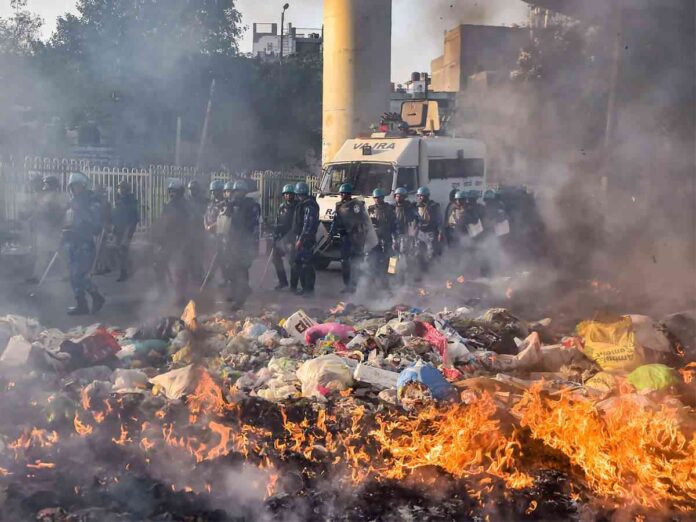A court here has convicted nine accused in a case related to the 2020 North East Delhi riots of various offences, including arson and theft.
The court held guilty Mohd. Shahnawaz, Mohd. Shoaib, Shahrukh, Rashid, Azad, Ashraf Ali, Parvez, Mohd. Faisal and Rashid, who were accused of being part of a riotous mob that robbed, damaged and set ablaze the house of the complainant, Rekha Sharma, on the intervening night of February 24 and 25, 2020 in Chaman Park on Shiv Vihar Tiraha Road.
“I find that charges levelled against all the accused persons in this case are proved beyond doubts,” Additional Sessions Judge Pulastya Pramachala said in an order passed on Monday.
“Hence, the accused are convicted for offences punishable under sections 147 (rioting), 148 (rioting, armed with a deadly weapon), 380 (theft in dwelling house), 427 (mischief causing damage of Rs 50 or upwards) and 436 (mischief by fire or explosive substance with intent to destroy house, etc.) of the Indian Penal Code ,” the judge said.
The accused were also convicted of offences under sections 149 (every member of unlawful assembly guilty of offence committed in prosecution of common object) and 188 (disobedience to order duly promulgated by public servant) of the IPC, the judge added.
The court has posted the matter for hearing arguments on sentencing on March 29, Special Public Prosecutor D K Bhatia said.
On the basis of the overall evidence, the judge said it was well established that an unlawful assembly was formed, which indulged in riots, vandalism and arson, besides damaging and burning the complainant’s property.
Regarding the identification of the accused persons, the judge said there was no material contradiction or infirmity in the testimony of Head Constable Hari Babu, who had identified them as part of the riotous mob.
Further, there was no reason to suspect the testimony of another on-duty Head Constable, Vipin Kumar, the judge said.
He observed that a witness could be tutored in respect of his statement to be given in the examination in chief, but no one could possibly know the questions to be put forth to such witnesss during the cross-examination by the opposite party.
“The cross-examination of a witness, hence, becomes an important tool to assess his credibility, while appreciating the coherence and consistency of his statement regarding the relevant facts deposed by him in his examination in chief,” the judge said.
The court also accepted the investigating officer’s (IO’s) reasons for the delay in the examination of both police officials, saying Delhi Police would have been “recovering” from the impact of the 2020 riots when they were also expected to enforce the norms because of Covid-19.
“It is true that in normal circumstances delayed examination of an eyewitness would give rise to a reason to be suspicious against the statement of such eyewitness. However, it depends upon case to case and the facts and circumstances of each case, to look into the credibility of given reasons behind such delay,” the court said.
It said the IO’s explanation could not be treated as an afterthought or said to be artificial.
“Therefore, all I can say is that the delay in the examination of prosecution witness 6 (Head Constable Babu) and PW7 (Head Constable Kumar) cannot be said to be without any cogent reasons. In the peculiar circumstances attached to this case, this delay and non-recording of such information in the police station, cannot be given over importance,” the judge said.
He said in some earlier cases involving the two police officials, the non-recording of vital information regarding involvement of particular persons in a particular incident at the earliest point of time, in the police station, invited adopting rule of prudence.
“However, on the basis of additional material and consequent explanations related to the credibility of PW6 and overall assessment of the evidence PW6 and PW7, the situation is altogether different, where there is no occasion to continue with my past approach,” the judge said.
He said on the basis of the assessment of the evidence and further reasoning, the court was convinced by the prosecution’s version against the accused.
“I find it well established that all the named accused persons did become part of an unruly mob, which was guided by communal feelings and was having a common object to cause maximum damage to the properties of persons belonging to the Hindu community,” the judge said.
He said both police officials had deposed that because of the minimal number of police personnel in comparison to the strength of the mob, they could not stop the rioters.
“In that situation, it looks very probable and natural that the police team would be at least making an appeal to the rioters to disperse and to go back while announcing the operation of the order under Section 144 (power to issue order in urgent cases of nuisance of apprehended danger) of the Code of Criminal Procedure (CrPC).
“But despite such appeal, the mob continued the rampage and in the continuity of their riotous acts, this mob which included accused persons, looted articles from the house of the complainant vandalized other articles in that property and thereafter, set this property on fire,” the judge said.
The Gokalpuri police station had filed a charge sheet against the accused.




